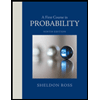
Consider a collection A1, … , Ak of mutually exclusive and
exhaustive events, and a random variable X whose distribution
depends on which of the Ai’s occurs (e.g., a commuter
might select one of three possible routes from home
to work, with X representing the commute time). Let
E(XuAi) denote the
Ai occurs. Then it can be shown that E(X) 5
oE(XuAi) ? P(Ai), the weighted average of the individual
“conditional expectations” where the weights are the probabilities
of the partitioning events.
a. The expected duration of a voice call to a particular
telephone number is 3 minutes, whereas the expected duration of a data call to that same number is 1 minute.
If 75% of all calls are voice calls, what is the expected
duration of the next call?
b. A deli sells three different types of chocolate chip
cookies. The number of chocolate chips in a type i
cookie has a Poisson distribution with parameter
mi 5 i 1 1 (i 5 1, 2, 3). If 20% of all customers
purchasing a chocolate chip cookie select the first
type, 50% choose the second type, and the remaining
30% opt for the third type, what is the expected number
of chips in a cookie purchased by the next customer?
Trending nowThis is a popular solution!
Step by stepSolved in 2 steps

- An analysis of personal loans at a local bank revealed the following facts: 10% of all personal loans are in default (D), 90% of all personal loans are not in default (D'), 20% of those in default are homeowners (H | D), and 70% of those not in default are homeowners (H | D'). If a personal loan is selected at random, P (D | H) = ___. O 0.78 0.02 0.03 0.18 O 0.63arrow_forwardI am having a tought time with this questionarrow_forwardLet X(1), X(2), ..., X(n) be the order statistics of a set of n independent uniform (0, 1) random variables.Find the conditional distribution of X(n) given that X(1) = s(1), X(2) = s(2), ..., X(n-1)=s(n-1).arrow_forward
- Let S be a sample space and E and F be events associated with S. Suppose that Pr(E) = 0.5, Pr(F) = 0.3 and Pr(ENF) = 0.2. Calculate the following probabilities. (a) Pr(E|F) (b) Pr(F|E) (c) Pr(티F') (d) Pr (E'JF') ... (a) To find Pr(E|F), simplify the fraction with Pr(EnF) in the numerator and Pr(F) in the denominator. Pr(E|F) = || |(Type an integer or a simplified fraction.)arrow_forwardx = 1,2,...,9. (This 2. Let X be a discrete random variable with pmf f(x) = log₁0 distribution, known as the Benford distribution, has been shown to accurately model the probabilities of the leading significant digit in numbers occurring in many datasets.) a) Verify that f(x) satisfies the conditions of a pmf. b) Find the cdf of X.arrow_forwardAn individual who has automobile insurance from a certain company is randomly selected. Let Y be the number of moving violations for which the individual was cited during the last 3 years. The pmf of Y is given. y 0 1 2 3 p(y) 0.60 0.20 0.15 0.05 (a) What is the probability that among 25 randomly chosen such individuals, at least 15 have no citations? (Round your answer to three decimal places.) (b) What is the probability that among 25 randomly chosen such individuals, fewer than half have at least one citation? (Round your answer to three decimal places.) (c) What is the probability that among 25 randomly chosen such individuals, the number that have at least one citation is between 10 and 15, inclusive? ("Between a and b, inclusive" is equivalent to (a ≤ X ≤ b). Round your answer to three decimal places.)arrow_forward
 A First Course in Probability (10th Edition)ProbabilityISBN:9780134753119Author:Sheldon RossPublisher:PEARSON
A First Course in Probability (10th Edition)ProbabilityISBN:9780134753119Author:Sheldon RossPublisher:PEARSON

